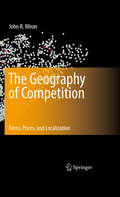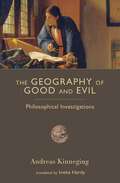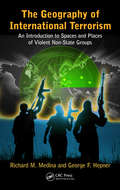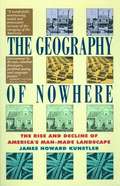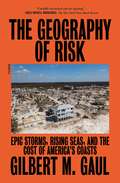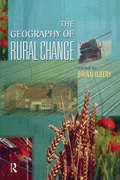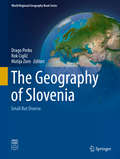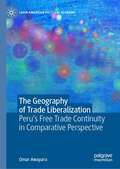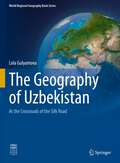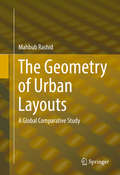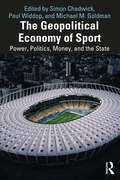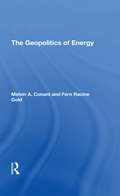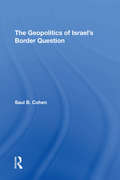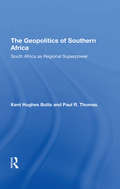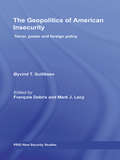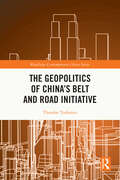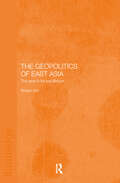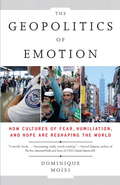- Table View
- List View
The Geography of Competition
by John R. MironThis book provides a comprehensive, up-to-date, and expert synthesis of location theory. What are the impacts of a firm's geographic location on the locations of customers, suppliers, and competitors in a market economy? How, when, and why does this result in the clustering of firms in space? When and how is society made better or worse off as a result? This book uses dozens of locational models to address aspects of these three questions. Classical location problems considered include Greenhut-Manne, Hitchcock-Koopmans, and Weber-Launhardt. The book reinterprets competitive location theory, focusing on the linkages between Walrasian price equilibrium and the localization of firms. It also demonstrates that competitive location theory offers diverse ideas about the nature of market equilibrium in geographic space and its implications for a broad range of public policies, including free trade, industrial policy, regional development, and investment in infrastructure. With an extensive bibliography and fresh, interdisciplinary approach, the book will be an invaluable reference for academics and researchers with an interest in regional science, economic geography, and urban planning, as well as policy advisors, urban planners, and consultants.
The Geography of Contemporary China (World Regional Geography Book Series)
by Peijun Shi Shunlin Liang Jing’ai WangThis textbook provides a comprehensive and very detailed insight into Chinese Contemporary Geography in English. It documents the geographical issues associated with China's rapid growth. Since initiating the reforms and open policy, China has achieved tremendous success. China's rapid growth is now a driving force in the global economy and is achieving unprecedented rates of poverty reduction. However, China also faces a number of sustainability and emerging challenges associated with rapid growth such as growing regional disparities in terms of per capita income and social-economic development, sustainable resource development, and issues related to regional and global economic integration. In addition, rapid economic growth has also brought about major challenges such as resource shortages, ecological and environmental destruction, land degradation and frequent disasters. This book presents the authors’ reflections. This lavishly illustrated book covers physical geography, history, and economic and political systems of the world's most populous country. The major focus is on geographical issues in China's contemporary development: agriculture, population, urbanization, resource and energy, and environment. The lead author of the book has taught relevant courses in China for three decades, and authored and edited multiple textbooks for Chinese students. This book will appeal to undergraduate students of geography and related disciplines with a regional focus on China and to the general reader who wants to learn different geographical aspects of modern China with little academic background in geography.
The Geography of Ethnic Violence: Identity, Interests, and the Indivisibility of Territory
by Monica Duffy ToftThe Geography of Ethnic Violence is the first among numerous distinguished books on ethnic violence to clarify the vital role of territory in explaining such conflict. Monica Toft introduces and tests a theory of ethnic violence, one that provides a compelling general explanation of not only most ethnic violence, civil wars, and terrorism but many interstate wars as well. This understanding can foster new policy initiatives with real potential to make ethnic violence either less likely or less destructive. It can also guide policymakers to solutions that endure. The book offers a distinctively powerful synthesis of comparative politics and international relations theories, as well as a striking blend of statistical and historical case study methodologies. By skillfully combining a statistical analysis of a large number of ethnic conflicts with a focused comparison of historical cases of ethnic violence and nonviolence--including four major conflicts in the former Soviet Union--it achieves a rare balance of general applicability and deep insight. Toft concludes that only by understanding how legitimacy and power interact can we hope to learn why some ethnic conflicts turn violent while others do not. Concentrated groups defending a self-defined homeland often fight to the death, while dispersed or urbanized groups almost never risk violence to redress their grievances. Clearly written and rigorously documented, this book represents a major contribution to an ongoing debate that spans a range of disciplines including international relations, comparative politics, sociology, and history.
The Geography of Good and Evil: Philosophical Investigations
by Andreas KinnegingDo good and evil exist? Absolutely. In this bracing book, the eminent Dutch philosopher Andreas Kinneging turns fashionable thinking on its head, revealing how good and evil are objective, universal, and unchanging—and how they must be rediscovered in our age. In mapping the geography of good and evil, Kinneging reclaims, and reintroduces us to, the great tradition of ancient and Christian thought. Traditional wisdom enables us to address the eternal questions of good and evil that confront us in both public and private life. Though it is common to accept uncritically the blessings of modernity and its intellectual sources, the Enlightenment and Romanticism, Kinneging shows that traditional thinking is richer and more realistic. Indeed, we see how, in more than a few respects, the Enlightenment and Romanticism brought not progress but deterioration. Kinneging skillfully reformulates and defends the insights of traditional thinking for today's readers, demonstrating how an objective morality is to be understood and how we can know what morality demands of us. At a time when the traditional virtues have practically disappeared from our language (that is, all but one—"tolerance"), he lays out the foundations of virtue and vice. Ultimately, Kinneging reveals the lasting significance of these seemingly archaic notions—to our own lives, to our families, to our culture, and to civilization. This profound, award-winning work establishes Andreas Kinneging as one of our wisest moral philosophers.
The Geography of Greece: Managing Crises and Building Resilience (World Regional Geography Book Series)
by Régis Darques George Sidiropoulos Kostas KalabokidisDuring the last few years, Greece has become a subject of increasing attention worldwide. Once praised for its ability to innovate and reform during the EU integration process, applauded for its remarkable job in managing the 2004 Olympics, the country fell into a financial crisis of unprecedented magnitude in 2008. Much has been said on this matter, and amid the morass of information a staggering number of untruths have been disseminated.In fact, the challenges of vulnerability and the paradigms of adaptation go way beyond finance and economy in Greece. Mega-fires, earthquakes, landslides and floods, migrations, sociopolitical upheavals, and armed conflicts generate emergency situations repeatedly. Because of its bridging role between natural and social sciences, geography can provide insights into the entire breadth of hazardous and chaotic events driving adaptation and change. Against all these threats, Greece has developed an enhanced resilience capacity. The purpose of this book is to help unravel the complexities of a fascinating country beyond clichés.This book is intended for students, researchers, scholars, and engineers interested in geography, land planning, urban studies, and environmental management. The crises issue intended as a guideline allows widening the audience to include the media, governmental and non-governmental agencies, and the public at large.
The Geography of Injustice: East Asia's Battle between Memory and History
by Barak KushnerIn The Geography of Injustice, Barak Kushner argues that the war crimes tribunals in East Asia formed and cemented national divides that persist into the present day. In 1946 the Allies convened the Tokyo Trial to prosecute Japanese wartime atrocities and Japan's empire. At its conclusion one of the judges voiced dissent, claiming that the justice found at Tokyo was only "the sham employment of a legal process for the satisfaction of a thirst for revenge." War crimes tribunals, Kushner shows, allow for the history of the defeated to be heard. In contemporary East Asia a fierce battle between memory and history has consolidated political camps across this debate. The Tokyo Trial courtroom, as well as the thousands of other war crimes tribunals opened in about fifty venues across Asia, were legal stages where prosecution and defense curated facts and evidence to craft their story about World War Two. These narratives and counter narratives form the basis of postwar memory concerning Japan's imperial aims across the region. The archival record and the interpretation of court testimony together shape a competing set of histories for public consumption. The Geography of Injustice offers compelling evidence that despite the passage of seven decades since the end of the war, East Asia is more divided than united by history.
The Geography of International Terrorism: An Introduction to Spaces and Places of Violent Non-State Groups
by Richard M. Medina George F. HepnerWhile geography is not the only factor to shape human behavior, its influence on terrorists motivations, behaviors, options, and activities is a primary consideration in understanding terrorism. Taking a different approach than many other books on terrorism, The Geography of International Terrorism: An Introduction to Spaces and Places of Violent
The Geography of Interwar Britain: The State and Uneven Development (Routledge Revivals)
by Stephen V. WardAs the first geographical study of interwar Britain, The Geography of Interwar Britain (originally published in 1988 and now with a new preface by the author) breaks new ground, incorporating original research and new interpretations of the work of historians and others within a geographical frame of reference.The central argument of the book is that the state in interwar Britain intensified uneven capitalist development. State actions in many important fields, including macro-economic policy, defence, industrial rationalisation, labour and unemployment policy, local government and regional policy, are analysed in detail. These studies show that, until the later 1930s, state policies worked to the disadvantage of depressed ‘outer’ Britain and favoured the more prosperous south and midlands. However, shifts in state policies were apparent as rearmament and changes in macro-economic policies necessitated new approaches. Significantly the first stages in the creation of what became the post-1945 political consensus were evident at this time, particularly in regional and industrial location policy.The book will be of interest to geographers, economic and social historians, political scientists, sociologists, and planners.
The Geography of Nowhere: The Rise and Decline of America's Man-Made Landscape
by James Howard KunstlerThis book traces the development of modern American car culture and the architecture and social life of cities and suburbs that developed around it.
The Geography of Risk: Epic Storms, Rising Seas, and the Cost of America's Coasts
by Gilbert M. GaulThis century has seen the costliest hurricanes in U.S. history—but who bears the brunt of these monster storms?Consider this: Five of the most expensive hurricanes in history have made landfall since 2005: Katrina ($160 billion), Ike ($40 billion), Sandy ($72 billion), Harvey ($125 billion), and Maria ($90 billion). With more property than ever in harm’s way, and the planet and oceans warming dangerously, it won’t be long before we see a $250 billion hurricane. Why? Because Americans have built $3 trillion worth of property in some of the riskiest places on earth: barrier islands and coastal floodplains. And they have been encouraged to do so by what Gilbert M. Gaul reveals in The Geography of Risk to be a confounding array of federal subsidies, tax breaks, low-interest loans, grants, and government flood insurance that shift the risk of life at the beach from private investors to public taxpayers, radically distorting common notions of risk.These federal incentives, Gaul argues, have resulted in one of the worst planning failures in American history, and the costs to taxpayers are reaching unsustainable levels. We have become responsible for a shocking array of coastal amenities: new roads, bridges, buildings, streetlights, tennis courts, marinas, gazebos, and even spoiled food after hurricanes. The Geography of Risk will forever change the way you think about the coasts, from the clash between economic interests and nature, to the heated politics of regulators and developers.
The Geography of Rural Change
by Brian IlberyThe Geography of Rural Change provides a thorough examination of the processes and outcomes of rural change as a result of a period of major restructuring in developed market economies. After outlining the main dimensions of rural change, the book progresses from a discussion of theoretical insights into rural restructuring to a consideration of both the extensive use of rural land and the changing nature of rural economy and society. The text places an emphasis on relevant principles, concepts and theories of rural change, and these are supported by extensive case study evidence drawn from different parts of the developed world.The Geography of Rural Change is written for undergraduates taking courses in human geography, agricultural geography, rural geography, rural sociology, planning and agricultural economics.
The Geography of Slovenia: Small But Diverse (World Regional Geography Book Series)
by Drago Perko Rok Ciglič Matija ZornThis book is the first to give a comprehensive and detailed overview of the complete geography of Slovenia in English. Only very few countries, even considerably larger ones, can boast the landscape diversity found in Slovenia since the Alps, the Pannonian Basin, the Dinaric Alps, and the Mediterranean meet and interweave in this small corner of Central Europe, as do Germanic, Hungarian, Slavic, and Romance cultural influences. The book provides a systematical overview of physical and human geographical elements of Slovenia from landforms to cultural characteristics. Special attention is given to landscape diversity, to the presentation of Slovene landscape types and regions, to some particularities and interesting facts of Slovenia, and to the position of Slovenia in the World. The book also illustrates some other important geographical phenomena, processes and interactions between nature and society in nowadays Slovenia. This volume appeals to researchers as well as students in the field of regional geography. It can also serve as a source for complete background information as well as a field guide for Slovenia.
The Geography of Survival: Ecology in the Post-Soviet Era
by Ze'ev WolfsonIn 1989 a Soviet environmental expert writer under the pseudonym Boris Komarov startled the world. His book "The Destruction of Nature in the Soviet Union", was both a chilling description of the environmental devastation in the Soviet Union and an indictment of the official policy and public apathy that allows it to be perpetuated. Today Boris Komarov writes freely under his own name - Ze'ev Wolfson. But the ecological crisis he documents has only become more severe, more widespread, more deadly. In "The Geography of Survival" Wolfson speaks out in unmistakable terms about the world's choice to embrace the cause of our collective survival or to let desertisation, pollution, disaster, famine, epidemic, and war work their own solution.
The Geography of Trade Liberalization: Peru’s Free Trade Continuity in Comparative Perspective (Latin American Political Economy)
by Omar AwaparaThis book answers why anti-trade forces in developing countries sometimes fail to effectively exert pressure on their governments. The backlash against globalization spread across several Latin American countries in the 2000s, yet a few countries such as Peru doubled down on their bets on free trade by signing bilateral agreements with the US and the EU. This study uses evidence from three Latin American countries (Peru, Argentina, and Bolivia) to suggest that geography can play a significant role in shaping trade preferences and undermining the formation and clout of distributional coalitions that seek protectionism. Because trade liberalization can have uneven distributional impacts along regional lines, trade liberalization losers can find themselves in unfavorable conditions to associate and engage in collective action. Under these circumstances, few coalitions emerge to battle for protection in the policy arena, and when they do, geographic distance from decision-makers in the capital city can be a significant barrier to realizing their interests. As a result, even where a majority of the population living in regions that have not benefitted from trade elect a leftist president, trade reform reversal will not occur unless protectionist interests are close to the capital city. The contrast between Peru, on one side, and Argentina and Bolivia, on the other, highlights the powerful influence geography can have on reversing trade policy or preserving the status quo.
The Geography of Uzbekistan: At the Crossroads of the Silk Road (World Regional Geography Book Series)
by Lola GulyamovaThis book describes the geography of Uzbekistan and its unique history and culture. It focuses on the development of Uzbekistan as a result of its location on the crossroads of the Silk Road. The influence of global and regional environmental challenges on the current landscape and similar issues are discussed and analyzed from a historical perspective. Contemporary tensions and reforms in social, economical and cultural life are described with the aim to draw a picture of modern paths to transformation and development. The Geography of Uzbekistan includes also information on geology, nature and natural resources, in particular water. The book discusses the social and environmental impacts of the Aral Sea disaster and shows new paths of transformation and development for this Central Asian country.
The Geometry of Urban Layouts
by Mahbub RashidThis book presents a compendium of the urban layout maps of 2-mile square downtown areas of more than one hundred cities in developed and developing countries--all drawn at the same scale using high-resolution satellite images of Google Maps. The book also presents analytic studies using metric geometrical, topological (or network), and fractal measures of these maps. These analytic studies identify ordinaries, extremes, similarities, and differences in these maps; investigate the scaling properties of these maps; and develop precise descriptive categories, types and indicators for multidimensional comparative studies of these maps. The findings of these studies indicate that many geometric relations of the urban layouts of downtown areas follow regular patterns; that despite social, economic, and cultural differences among cities, the geometric measures of downtown areas in cities of developed and developing countries do not show significant differences; and that the geometric possibilities of urban layouts are vastly greater than those that have been realized so far in our cities.
The Geopolitical Economy of Sport: Power, Politics, Money, and the State
by Simon Chadwick, Paul Widdop, and Michael M. GoldmanThis is the first book to define and explore the geopolitical economy of sport – the intersection of power, politics, money, and state interests that both exploit and shape elite sport around the world. Russia’s invasion of Ukraine, the global response, and the consequent ramifications for sport have put the geopolitical economy of sport front and centre in both public debate and academic thinking. Similarly, the Winter Olympics in Beijing and the FIFA World Cup in Qatar illustrate the political, economic, and geographic imperatives that shape modern sport. This book brings together studies from around the world to describe this new geopolitical economy of sport, from the way in which countries use natural resource revenues, accusations of sport washing, and the deployment of sport for soft power purposes, to the way in which sport has become a focus for industrial development. This book looks at the geopolitical economy of sport across the globe, from the Gulf States’ interests in European soccer to Israel seeking to build a national competitive advantage by positioning itself as a global sports tech start-up hub, and the United States continuing to extend its economic and cultural influence through geopolitical sport activities in Africa, Latin America, and the Indian subcontinent. This book captures a pivotal moment in the history of sport and sport business. This is essential reading for any student, researcher, practitioner, or policymaker with an interest in sport business, the politics of sport, geopolitics, soft power, diplomacy, international relations, or international political economy.
The Geopolitics Of Energy
by Melvin A Conant Fern R GoldHow can the industrialized countries reduce their vulnerability to supply disruptions caused by continued dependence on foreign sources of oil? How can access to Middle East oil be made more secure? These are the core questions that arise from a new worldwide energy situation in which the industrialized countries have remained dependent on oil and oil imports for their economic, political, and military well-being, while control of these resources has passed to an increasingly small number of less-developed countries whose interests do not automatically or necessarily coincide with those of the consuming, industrialized countries. With a focus on these questions, The Geopolitics of Energy analyzes the present worldwide energy situation and its likely evolution over the remainder of the century. The authors consider likely developments in coal, gas, and nuclear energy; the outlook for oil, which will remain the dominant energy source at least through the 1990s; and the implications of this energy outlook for U.S. foreign policy, intra-Western alliance relations, and North-South and East-West relations. Identifying the issues that will concern governments as long as the need for oil is pervasive-until alternative energy sources begin contributing significantly to world energy supply-the authors conclude with policy recommendations for the United States based on their analysis of the energy situation and its consequences. This book is based on a report prepared for the U.S. Department of Defense.
The Geopolitics Of Israel's Border Question
by Saul B CohenThis study addresses possible border adjustments between Israel and a potential Palestinian political entity, and with Syria on the Golan. It also addresses the complexities of the territorial imperative.
The Geopolitics Of Southern Africa: South Africa As Regional Superpower
by Kent H Butts Paul R ThomasSouth Africa is the dominant force in an area that is of increasing strategic importance to the West, yet few studies address the geopolitical pressures that dictate the course of events there. Analyzing South Africa’s base of power, the authors argue that because South Africa’s relationships with other states in Southern Africa are asymmetrical in nature, the country has substantial economic and political leverage in the region. Control of Southern Africa’s transport infrastructure and the ability to project a conventional or surrogate military presence throughout the region, for example, gives South Africa the power to affect the economic and political stability of virtually all regional states. Asymmetry also characterizes relationships at the global level. Because the West depends upon South Africa for access to the region’s strategic minerals, for the security of the Cape oil route, and for the country’s ability to counterbalance the Soviet presence in Southern Africa, South Africa exercises considerable influence over the African foreign policies of the superpowers. Focusing on the major geopolitical variables affecting South Africa’s ability to sustain power, the authors analyze the economic and geographic factors that contribute to asymmetrical relationships and examine the pluralism that divides South African society. Pretoria’s successful foreign policy, which has created a security corridor of new buffer states, is given particular emphasis. In addition, the authors provide a detailed analysis of South Africa’s minerals-based economy and discuss the implications for regional stability of economic sanctions against South Africa. Finally, they outline a policy framework that takes regional economic, political, and geographic realities into account.
The Geopolitics of American Insecurity: Terror, Power and Foreign Policy (PRIO New Security Studies)
by Francois Debrix Mark LacyThis edited volume examines the political, social, and cultural insecurities that the United States is faced with in the aftermath of its post-9/11 foreign policy and military ventures. The contributors critically detail the new strategies and ideologies of control, governance, and hegemony America has devised as a response to these new security threats. The essays explore three primary areas. First, they interrogate the responses to 9/11 that resulted in an attempt at geopolitical mastery by the United States. Second, they examine how the US response to 9/11 led to attempts to secure and control populations inside and outside the United States, resulting in situations that quickly started to escape its control, such as Abu Ghraib and Katrina. Lastly, the chapters investigate links between contemporary regimes of state control and recently recognized threats, arguing that the conduct of everyday life is increasingly conditioned by state-mobilized discourses of security. These discourses are, it is argued, ushering in a geopolitical future characterized by new insecurities and inevitable measures of biopolitical control and governance.
The Geopolitics of China's Belt and Road Initiative (Routledge Contemporary China Series)
by Theodor TudoroiuThis book argues that China’s Belt and Road Initiative should be seen more as a geopolitical project and less as a global economic project, with China aiming to bring about a new Chinese-led international order. It contends that China’s international approach has two personas – an aggressive one, focusing on a nineteenth century-style territorial empire, which is applied to Taiwan and the seas adjacent to China; and a new-style persona, based on relationship building with the political elites of countries in the Global South, relying on large scale infrastructure projects to help secure the elites in power, a process often leading to lower democratic participation and weaker governance structures. It also shows how this relationship building with elites leads to an acceptance of Chinese norms and to changes in states’ geopolitical preferences and foreign policies to align them with China’s geopolitical interests, with states thereby joining China’s emerging international order. Overall, the book emphasises that this new-style, non-territorial “empire” building based on relationships is a major new development in international relations, not fully recognised and accounted for by international relations experts and theorists.
The Geopolitics of Culture: James Billington, the Library of Congress, and the Failed Quest for a New Russia (NIU Series in Slavic, East European, and Eurasian Studies)
by John Van OudenarenThrough the lens of James Billington and the institution he led as Librarian of Congress during a key period of US-Russian relations, The Geopolitics of Culture examines culture as a neglected area of US foreign policy. Billington advised presidents and members of Congress and mobilized the resources of the Library of Congress to promote reform in Russia. He believed that rather than preaching to the Russians, the United States should expose the rising generation of Russian leaders to what was best in America and encourage them to rediscover positive elements in pre-Bolshevik Russian culture.The Geopolitics of Culture is the first book to chronicle Billington's influence on US engagement with Russia as it transitioned from communism to democracy under Gorbachev and Yeltsin and back to authoritarianism under Yeltsin and Putin. Drawing on published and archival sources (including recently released papers) and interviews with current and retired Library of Congress staff members, John Van Oudenaren casts new light on this era.Billington's efforts led to a remarkable degree of cooperation between the Library of Congress and Russian cultural and political institutions. Yet these efforts ultimately failed as Putin turned back toward authoritarianism. The experience of the Library of Congress during this period nonetheless holds important lessons for today. Billington believed that a transition to democracy in Russia was essential if the United States was to head off the geopolitical nightmare of a Eurasia dominated by an alliance of hostile authoritarian powers. The "geopolitics of culture" thus remains a challenge for US foreign policy.
The Geopolitics of East Asia: The Search For Equilibrium
by Robyn LimEast Asia is a potential area of international conflict, with a number of possible 'flashpoints' and with the absence of strong regional organisations able to deal with conflict resolution. At the same time, global powers frequently get involved in the international politics of the region in order to protect their interests. This book presents a comprehensive overview of the geopolitics of the region. It focuses in particular on the way geographical and historical forces continue to play a key role in shaping international relations here. It considers the role of both regional and international powers, and assesses the risks of war in the region.
The Geopolitics of Emotion
by Dominique MoisiIn the first book to investigate the far-reaching emotional impact of globalization, Dominique Moïsi shows how the geopolitics of today is characterized by a "clash of emotions." The West, he argues, is dominated and divided by fear. For Muslims and Arabs, a culture of humiliation is quickly devolving into a culture of hatred. Asia, on the other hand, has been able to concentrate on building a better future, so it is creating a new culture of hope. Moïsi, a leading authority on international affairs, explains that in order to understand our changing world, we need to confront emotion. And as he makes his case, he deciphers the driving emotions behind our cultural differences, delineating a provocative and important new perspective on globalization.From the Trade Paperback edition.t or transcend them. For Muslims and Arabs, the combination of historical grievances, exclusion from the economic boon of globalization, and civil and religious conflicts extending from their homelands to the Muslim diaspora have created a culture of humiliation that is quickly devolving into a culture of hatred. Meanwhile, Asia has been able to concentrate on building a better future and seizing the economic initiative from the American-dominated West and so creating a new culture of hope.Do these emotions represent underlying cultural tendencies characteristic of particular regions and populations today? How will these varying emotions influence the political, social, and cultural conflicts that roil our world? How can the West transcend its fear and avoid sliding into protectionism or militarism? What can the Muslim world do to overcome is legacy of humiliation? Will China and India manage to maintain their status as the cultures of hope? And what will the effect of the world economic crisis be? By delineating the necessity of confronting emotions to understand our changing world and deciphering the driving emotions behind our cultural differences, The Geopolitics of Emotion presents a provocative new perspective on globalization.
